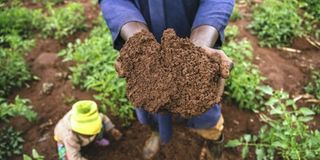Reflections on World Soil Day

December 5 is celebrated annually as World Soils Day. The theme for this year is ‘Soils: Where Food Begins’. Although the importance of soil to plant, animal, human and environmental and therefore, to one health is gaining recognition, it is not happening fast enough and at the scale it should be.
Soil is home to 25 percent of all the biodiversity on earth. There is no other place on earth as packed with life per unit volume as the soil. In one square metre of natural forest soil, there can be more than 1,000 different species of invertebrates alone and countless numbers of actinorhizae, protozoa and viruses.
The population of bacteria alone in one gram of a productive soil can exceed the total population of all humans on earth (species abundance! According to an FAO document on soil biodiversity, a typical healthy soil could contain several species of vertebrate animals, and earthworms, 20 – 30 species of mites, 50 – 100 species of insects, tens of species of nematodes, hundreds of species of fungi and perhaps thousands of species of bacteria and actinomycetes (species diversity).
Soil is also home to the largest organism living on Earth: a honey fungus stretching over an area of nine square miles!
This wealth of soil organisms are structurally and functionally linked through the soil food web: a web of ecological activity formed by soil organisms as they interact with each other. The relationship starts with use of sunlight to convert water and carbon dioxide into biomass by organisms which possess chlorophyll, a process known as photosynthesis.
Apart from carbon, oxygen and hydrogen that plants derive from the atmosphere in form of water and carbondioxide, the rest of the nutrients obtained from the soil. All the rest of organisms on earth including humans, depend on this biomass for food. In this sensitive and delicate relationship, each organism depends on others as much as others depend on it. In these delicate functional relationships, any effect on anyone soil organism will impact others too, directly or indirectly.
So beaming is soil with life that it is itself regarded a super living organism on the earth’s surface. When it goes wrong with the soil therefore, it cannot be right anywhere. A fertile, well-conserved and healthy soil will reward us with clean freshwater, clean air and abundant harvest of nutritious, safe health-giving food. A degraded and polluted soil will punish us with poor harvest of sick food, water and air, exacerbating plant, animal, human and environmental health: that is, one health put in trouble.
In the parable of the Sower, the path symbolizes a compacted surface. Soils can be compacted by trampling on by heavy machinery or erosion of topsoil. Rocky ground can also result from loss of clay- and organic-rich topsoil, exposing underlying rocky surface. Plants can’t grow roots deep enough into compacted or rocky soil surfaces. Thorny vegetation symbolizes harsh soil and weather conditions with extremes of drought and soil degradation and fields with such vegetation cannot support crops. A healthy soil is deep and fertile and the grain that falls on it yields as much as 100-fold the yield in the degraded soils Jesus alludes to (Mtt 13:1-8).
Toxic synthetic fertilisers, toxic organic fertilisers, toxic synthetic pesticides and weaponised seeds (GMOs) as well as growth regulators and human waste damage the soil and destroy the earth and harm our health. These crimes against the Earth are punishable by death (Rev 11:18) and the Vatican already evoked the powers in Mtt 16:19 to add polluting the earth among the list of mortal sins in 2015.
Authored by Giregon Olupot,soil scientist Makerere University.




